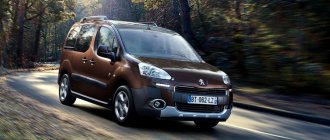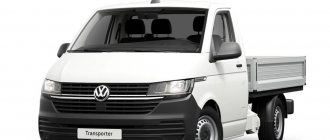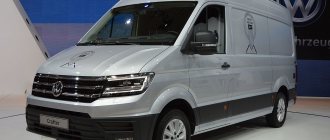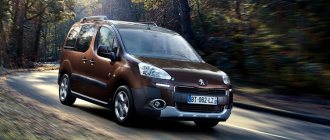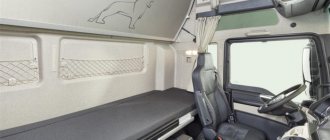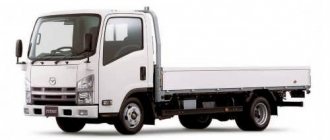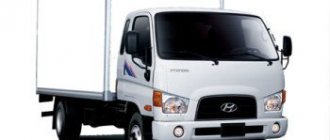The Peugeot Partner is a versatile car that is available in two variations: a compact van and a van with an all-metal body. The vehicle has gained popularity in the commercial and family sectors. In the first case, the cargo version is preferable, and in the second, the cargo-passenger version. Regardless of the features of the body part, the car has established itself as a reliable and functional vehicle. This result is explained by the harmonious relationship between efficiency, power and capabilities of the internal combustion engine.
Peugeot Partner
Model history
The Peugeot Partner was introduced in 1996, at the same time as its sister Citroen Berlingo. In technical terms, the cars are almost completely identical. In 1997, mass deliveries to the market began with naturally aspirated engines: gasoline 1.1 l/60 hp, 1.4 l/75 hp, 1.8/90 hp. and diesel 1.8 D/60 hp. and 1.9 D/68-69 hp. In 2000, a new turbodiesel 2.0 HDi 90 hp appeared in the range. with common rail injection system. In 2001, the gasoline 1.8 was replaced with a new 16-valve engine 1.6 l/109 hp.
In 2003, restyling was carried out. Shortly before the generation change, in 2006, they offered a new 1.6 HDi/75 and 90 hp turbodiesel, which Peugeot, Citroen and Ford worked on. In 2008, production of the first generation model ended. However, the first Partner continued to be assembled in Turkey, from where the cars were supplied to other markets.
Design features
Peugeot Partner immediately became a great success. Today there are a sufficient number of offers on the secondary market. Among them are passenger, universal, cargo and even off-road versions. The first option is made with an emphasis on comfort. The universal modification can be used for business and work on weekdays, and on weekends it can act as a car for personal and family needs. The cargo model offers only a 2-seat interior and a 3 m3 cargo compartment. Other modifications have a trunk with a capacity of 624-664 liters.
The car's interior will delight passengers with a large number of different compartments for small items and spaciousness. Even passengers in the rear seats, accessible through the large sliding side doors, will not feel at a disadvantage. They can be on one or both sides of the car. Many examples do not have a sliding side door on the left.
However, in the samples of the first years of production, sliding doors were not offered. It was possible to get to the back row only through the reclined back of the front seat, which caused serious inconvenience.
An important stage in the life of the first generation Peugeot Partner was 2003, when a restyled version of the model entered the market. The rejuvenation affected not only the appearance (the headlights increased in size), but also the interior decoration. The new front panel has become more convenient. The range of equipment has also expanded.
Access to the cargo compartment is either through the rear hatch, which folds upward, or through the hinged doors. The second option is most common.
Under the hood in the engine compartment
A compact gasoline engine lives at ease here. Front-wheel drive, transverse engine arrangement. The layout of the engine compartment should not frustrate the auto mechanic. You can get to everything with minimal additional work. The numerous flimsy-looking plastic auxiliary components are a little confusing: brackets, clamps, covers, and the like. But cars have been mass-produced for several years, which means that, in theory, they have confirmed their viability.
Engines
The base 1.1 and 1.4 liter petrol engines suffer from a lack of power. The ideal choice would be the 1.6-liter 16-valve 4-cylinder naturally aspirated, but it was only available until 2001. Those who want to purchase an older Partner with a gasoline engine will have to settle for a 1.4-liter unit or a 1.8-liter 8-valve unit. Gasoline engines are reliable. Possible interruptions in operation during long mileage may be caused by failure of attachments (for example, sensors).
Some customers, especially in Europe, prefer diesel. The outdated naturally aspirated diesel has the best reputation. In 2000, the 2.0 HDi appeared, which is almost as reliable and much more economical. However, with significant mileage, problems with injectors cannot be avoided (from 30,000 rubles apiece). Fortunately, in 2.0 HDi they have a higher resource than in the highly boosted 1.6 HDi. However, with age, both suffer from problems with the EGR valve, turbocharger and throttle valve. Oil leaks are no exception.
In the event of a malfunction of the turbocharger in the 1.6 HDi (from 22,000 rubles for an analogue, 80,000 rubles for an original), a simple replacement will not get rid of it. The primary cause of premature wear is an oil supply channel clogged with sludge (3,000 rubles). If the problem is not fixed, then the new turbine will not last long.
Due to the rather high drag of Peugeot, all engines consume a significant amount of fuel. If you don’t have to travel a lot, then you can decide to buy a gasoline version. In a leisurely city rhythm with engines of 1.4 and 1.6 liters, you can meet 7-9 liters of gasoline per 100 km.
City work
Let's warm up the modest 1.6-liter gasoline engine and get to work; we need to take care of some small things. There are no surprises along the way. The manual transmission joystick on the center console is conveniently located and works well. 115 hp at almost six thousand revolutions and 150 Nm at 4000 rpm for a city full of cameras, one might say, is enough, if not demonstrating a driving style that is always late for nowhere. The unexpected high elasticity of the engine allows you not to fuss with the choice of gears, despite the small displacement and modest power figures. Noble.
The van's handling is difficult to characterize in terms of the selection of evaluation criteria. What is bad for business class is quite suitable for delivery commercial vehicles. In general, the settings are pleasant, largely consistent with the first generation of “Partners”, but the car has gotten rid of the jumping characteristic of the previous model. Obviously, steering feedback was sacrificed for the sake of ease of maneuvering, which is much more important for a city delivery van.
Sound insulation is predictably minimal. In front, the gasoline heart is clearly beating; in the back, the rhythmic hubbub of the wheel arches clearly hints that the car is currently moving.
The different-sized swing doors of the 3.3-cubic-meter cargo compartment will be appreciated by professional couriers; for the average person they offer little value. But we can praise the designers for the fact that the rear wheel arches are linked to the side walls so that they hardly stick out, forming an almost rectangular area for placing cargo. Great!
Typical problems and malfunctions
When purchasing a Peugeot Partner, you should pay attention to the condition of the rear axle - most often wheel bearings are rented (from 2,000 rubles, complete with hub). If the rear wheels are stacked (A), then the rear beam needs investment. As a rule, this happens after 200,000 km.
On the front axle, the anti-roll bar strut and bushing periodically require replacement (about 1000 and 800 rubles per pair, respectively). Over time, the support bearings of the front struts begin to knock (about 600 rubles for one). You rarely have to deal with wear on ball joints. The design provides for their replacement - 600 rubles apiece.
You should also check the operation of the power steering, which sometimes fails. You will have to pay at least 20,000 rubles for a new pump. There are malfunctions in the operation of electrical equipment, especially in restyled versions. For example, the steering column switches stop functioning. Eliminating the defect will require large investments - from 20,000 rubles for a new unit.
Problems can also arise with sliding doors. Sand gets into the guides, the sliding mechanism wears out and the doors jam. Problems with doors also arise after repairing body damage resulting from an accident.
Intensive use on most copies leaves an indelible mark.
Get behind the wheel straight away
Externally, the “Partner” has changed the front bumper, the configuration of the head optics has changed slightly, and LED running lights have appeared.
On a new car today, electronic displays and indicators cannot be found in the cockpit, and anti-lock brakes and power steering are basic options. The high “a la bus” seating position and sensitive lumbar support confused me a little at first, but my fears were not confirmed - it’s comfortable to sit.
Let's adjust the mirrors and steering column. Since I need the steering wheel to slightly overlap the upper sector of the dashboard, I’ll have to look there when stopping at traffic lights. Moreover, all instrument “hazards” are duplicated by sound signals. I had to reach out to adjust the mirrors - there is no electrical adjustment. There is no heating, and it’s winter, winter, winter outside...
The pedal assembly looks like a podium: all three pedals are in different planes. So as not to get confused? Everything is fine with the gas and brake, but the clutch pedal lies higher and more horizontal, it feels strange, but the clutch itself works well: the squeezing force is not great, the grip point is clearly felt.
The vertical space in a cargo van is natural - there is no feeling of cramping if you have to travel far, this is a blessing. There are a lot of niches for things and pockets, but the glove box with a lid is only on top of the dashboard on the driver's side. There was no convenient tray for a modern smartphone...
Again, the unconventional French tradition caught my eye in the form of an odd speedometer graduation.
The tiny information display on top of the “beard” of the center console flickers with an abundance of information: date and time, outside temperature, radio frequency, mobile phone connection, daily odometer, average fuel consumption, average speed. A total of 8 parameters on a panel the size of a pair of matchboxes – the nuances of a budget commercial vehicle.
